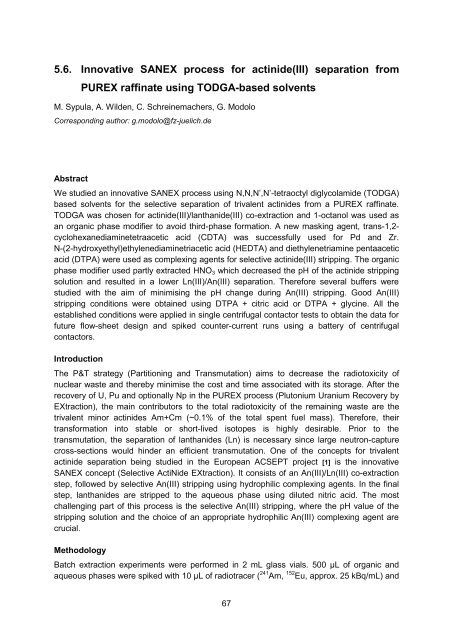Annual Report 2009/2010 - JUWEL - Forschungszentrum Jülich
Annual Report 2009/2010 - JUWEL - Forschungszentrum Jülich
Annual Report 2009/2010 - JUWEL - Forschungszentrum Jülich
You also want an ePaper? Increase the reach of your titles
YUMPU automatically turns print PDFs into web optimized ePapers that Google loves.
5.6.<br />
Innovative SANEX process for actinide(III) separation from<br />
PUREX raffinate using TODGA-based solvents<br />
M. Sypula, A. Wilden, C. Schreinemachers, G. Modolo<br />
Corresponding author: g.modolo@fz-juelich.de<br />
Abstract<br />
We studied an innovative SANEX process using N,N,N’,N’-tetraoctyl diglycolamide (TODGA)<br />
based solvents for the selective separation of trivalent actinides from a PUREX raffinate.<br />
TODGA was chosen for actinide(III)/lanthanide(III) co-extraction and 1-octanol was used as<br />
an organic phase modifier to avoid third-phase formation. A new masking agent, trans-1,2-<br />
cyclohexanediaminetetraacetic acid (CDTA) was successfully used for Pd and Zr.<br />
N-(2-hydroxyethyl)ethylenediaminetriacetic acid (HEDTA) and diethylenetriamine pentaacetic<br />
acid (DTPA) were used as complexing agents for selective actinide(III) stripping. The organic<br />
phase modifier used partly extracted HNO 3 which decreased the pH of the actinide stripping<br />
solution and resulted in a lower Ln(III)/An(III) separation. Therefore several buffers were<br />
studied with the aim of minimising the pH change during An(III) stripping. Good An(III)<br />
stripping conditions were obtained using DTPA + citric acid or DTPA + glycine. All the<br />
established conditions were applied in single centrifugal contactor tests to obtain the data for<br />
future flow-sheet design and spiked counter-current runs using a battery of centrifugal<br />
contactors.<br />
Introduction<br />
The P&T strategy (Partitioning and Transmutation) aims to decrease the radiotoxicity of<br />
nuclear waste and thereby minimise the cost and time associated with its storage. After the<br />
recovery of U, Pu and optionally Np in the PUREX process (Plutonium Uranium Recovery by<br />
EXtraction), the main contributors to the total radiotoxicity of the remaining waste are the<br />
trivalent minor actinides Am+Cm (~0.1% of the total spent fuel mass). Therefore, their<br />
transformation into stable or short-lived isotopes is highly desirable. Prior to the<br />
transmutation, the separation of lanthanides (Ln) is necessary since large neutron-capture<br />
cross-sections would hinder an efficient transmutation. One of the concepts for trivalent<br />
actinide separation being studied in the European ACSEPT project [1] is the innovative<br />
SANEX concept (Selective ActiNide EXtraction). It consists of an An(III)/Ln(III) co-extraction<br />
step, followed by selective An(III) stripping using hydrophilic complexing agents. In the final<br />
step, lanthanides are stripped to the aqueous phase using diluted nitric acid. The most<br />
challenging part of this process is the selective An(III) stripping, where the pH value of the<br />
stripping solution and the choice of an appropriate hydrophilic An(III) complexing agent are<br />
crucial.<br />
Methodology<br />
Batch extraction experiments were performed in 2 mL glass vials. 500 μL of organic and<br />
aqueous phases were spiked with 10 μL of radiotracer ( 241 Am, 152 Eu, approx. 25 kBq/mL) and<br />
67
















